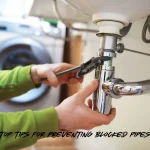Have you ever found yourself in a hardware store, staring at a shelf of pipes and wondering what those letters mean? FIP, NPT, MIP—it can sound like a secret code! Don’t worry, you’re not alone. Years ago, I helped my neighbor replace a leaky kitchen faucet, and neither of us knew what FIP meant. We spent more time confused than working! This guide is here to clear all that up, using stories, simple explanations, and advice trusted by professional plumbers.
What Does FIP Stand for in Plumbing?
FIP stands for Female Iron Pipe. In plumbing, “FIP” means the part or fitting has threads on the inside. It’s called “female” because it’s designed to have another pipe or fitting (with external threads) screwed into it.
Imagine a nut and a bolt. The FIP is like the nut. It waits for the “male” piece—called MIP—to fit in.
-
F: Female (inside threads)
-
I: Iron (standard pipe size, doesn’t have to be made of iron)
-
P: Pipe (used for plumbing joints)
You’ll see FIP most on fittings for faucets, fixtures, shut-off valves, or any place you want to attach a pipe with outside threads. Knowing this can keep you from buying the wrong part—a mistake I once made during a bathroom upgrade!
Why Do Plumbers Use FIP?
Plumbers trust FIP fittings because:
-
They create reliable, water-tight seals.
-
They’re easy to connect and disconnect for repairs.
-
They work with many materials: brass, PVC, steel, copper, and more.
One summer, I helped my uncle re-plumb an old laundry room. Every shut-off valve was a FIP fitting. They’re everywhere in a house, and you may never notice them until you try a repair them yourself!
FIP Is Everywhere in Your Home
Look around. You’ll often find FIP:
-
At the end of the water supply lines under sinks
-
On the shower arm connections
-
On outdoor hose bibbs (the faucet your garden hose attaches to)
-
For connecting water heaters
-
On shut-off valves
Once, when I tried to install a washing machine, I noticed the supply hose had “FIP” in tiny letters on the label. It was a relief to understand what those letters meant!
How Do You Identify FIP?
-
Check the inside of the fitting: If the threads are inside, it’s female (FIP).
-
The packaging may say “1/2-inch FIP” or “3/4-inch FIP.”
-
It usually connects to something labeled “MIP,” meaning Male Iron Pipe (outside threads).
Sometimes, you’ll see “NPT FIP.” That just means the threads meet U.S. National Pipe Thread standards (explained below).
Are FIP and NPT the Same?
They are related, but not the same:
-
FIP tells you it’s a female fitting (inside threads).
-
NPT stands for National Pipe Thread—it’s how the threads are shaped and sized.
So, most FIP fittings use NPT threading, meaning they are “female” connectors that fit NPT “male” pipes. Almost all U.S. plumbing threads are NPT.
It’s like saying “a chocolate cupcake”: “cupcake” is the type (female fitting/FIP), “chocolate” is the flavor (thread type/NPT).
Quick Insight
When shopping for plumbing parts, you may see “FIP,” “NPTF,” or just “NPT (female).” All three usually mean a female fitting with National Pipe Thread standards. To be certain, check the packaging or ask a store expert.
What are MIP and FIP in Plumbing?
-
FIP (Female Iron Pipe): Threads on the inside
-
MIP (Male Iron Pipe): Threads on the outside
Plumbing is like a handshake—FIP and MIP shake hands to make a water-tight connection.
Example from Life
A friend called one Saturday, worried: “I have a half-inch pipe, but the new shut-off valve won’t fit!” Turned out, she had an FIP valve and needed an MIP connector. Just knowing this simple trick saved her a trip back to the store!
What Does FIP Mean?
-
“Female Iron Pipe”
-
Means internal threads
-
Fits over pipes or fittings with matching external threads (MIP)
-
Common in home water lines, valves, and fixture hookups
If you see FIP, remember: it’s the “nut” part of the nut-and-bolt pair.
Unique Insights from Plumbing Experts
1. FIP Is About the Threads, Not Always Iron
Despite the name, FIP fittings come in brass, plastic, stainless steel, and copper, not just iron pipe. The “Iron Pipe” part refers to the size standard used across plumbing, not the material itself.
2. FIP Needs Sealant
Even though the threads are tight, experts always use plumber’s tape (PTFE/Teflon tape) or a thread sealant for leak-free joints. If you don’t, you might see a slow drip hours—or days—after turning the water on.
“Any time I skip the tape, I regret it,” one plumber told me after a call-back for a tiny leak.
3. Not All Threads Mix
Some parts, especially imported ones, use different systems (like BSP for British Standard Pipe). The U.S. standard is NPT. FIP fittings made to NPT and BSP standards will not connect properly. If a fitting just won’t screw on easily, double-check the label before forcing anything!
Table: Quick Guide to FIP and Related Terms
| Abbreviation | Full Name | Thread Location | Pairs With | Common Use |
|---|---|---|---|---|
| FIP | Female Iron Pipe | Inside | MIP | Valves, elbows |
| MIP | Male Iron Pipe | Outside | FIP | Pipe ends, nipples |
| NPT | National Pipe Thread | Inside/Outside | FIP/MIP | Most U.S. plumbing |
| BSP | British Standard Pipe | Inside/Outside | BSP | UK, Australia |
Personal Anecdotes: Lessons Learned
Understanding Thread Direction
The first time I tried plumbing, I accidentally bought two FIP fittings, thinking I could join them. They both had threads on the inside, so of course, they wouldn’t screw together! It was a real “aha” moment—FIP and MIP always go together.
Mix-ups and Fixes
I once tried to help my grandfather with his old garden hose. We bought the wrong replacement part: it was an MIP when we needed a FIP. We had to ask three employees (and laugh at ourselves) before we got it right. Since then, I always bring the old fitting to the store—it makes matching a breeze.
Pro Tips for Choosing FIP Parts
-
Bring the old part with you: Matching by sight is much easier than by memory.
-
Label saved pieces: Use tape to mark “FIP” or “MIP” so you don’t forget next time.
-
Don’t over-tighten: Just a gentle snug with a wrench is fine; too much can crack brass or plastic.
-
Use thread tape: A wrap or two on MIP threads makes a leak-free seal with FIP.
-
If in doubt, ask: Hardware store staff and plumbers are used to these questions, and have made the same mistakes before!
Real World: Where Do You Find FIP?
-
Sinks: Shut-off valves, faucet tailpieces
-
Toilets: Water supply valve connections
-
Showers: Arm fitting into the wall
-
Hot water heaters: Cold/hot water inlet and outlet pipes
-
Outdoor spigots: Hose bib attached to house piping
Knowing what to look for takes the guesswork out of DIY fixes!
FAQs for Homeowners
What Does FIP Stand For in Plumbing?
Female Iron Pipe—it’s a pipe or fitting with inside threads, common on faucets, valves, and connectors.
Are FIP and NPT the Same?
Not exactly. FIP means it’s a female-threaded fitting. NPT is a thread shape and standard. Most FIP fittings use NPT threads.
What are MIP and FIP in Plumbing?
FIP = Female Iron Pipe (inside thread). MIP = Male Iron Pipe (outside thread). You screw a MIP into an FIP to connect two pipes or a pipe to a fixture.
What Does FIP Mean?
FIP is the industry term for a female (inside-threaded) pipe fitting, used throughout residential and commercial plumbing.
Unique Insights for Easy DIY Plumbing
1. Fittings Aren’t Just Pipe-to-Pipe
You’ll find FIP threads used on many plumbing devices, like pressure gauges, filter housings, and even on some kitchen sprayers.
2. See and Feel Before You Buy
If you’re ever unsure, politely ask to open the fitting package or compare in-store. The threads should be smooth and the right size—no force required.
3. “Iron Pipe” Size Isn’t Always Iron
The plumbing world kept the “Iron Pipe” name to help standardize sizes, even as new materials appeared. Don’t worry if your “iron pipe” fitting is bright shiny brass or white PVC!
4. Check Local Codes
Some areas require specific materials (like lead-free brass) for water supply connections. Always check before starting renovations.
How to Make a Solid FIP Connection: Step by Step
-
Wrap the matching MIP threads with plumber’s tape.
-
Position the FIP fitting over the MIP threads.
-
Turn by hand until snug.
-
Use a wrench for a final gentle turn (do not overtighten).
-
Turn on the water and check for leaks. If it drips, try tightening a bit more, but never force.
Final Thoughts
Understanding FIP in plumbing goes far beyond memorizing a three-letter abbreviation. It’s about knowing what parts fit where, avoiding frustrating mistakes, and getting your DIY plumbing projects done with confidence. I used to feel lost in the plumbing aisle; now, after a few small victories (and some fails!), I check each part for the right thread, size, and label before buying.
If you take away one thing, let it be this: If it has threads on the inside, it’s probably a FIP fitting. And that little bit of knowledge can make your next plumbing project a whole lot easier!
Plumbing doesn’t have to be mysterious—knowing terms like FIP helps you take charge of your home repairs, avoid unneeded trips to the store, and feel much more confident every step of the way.










